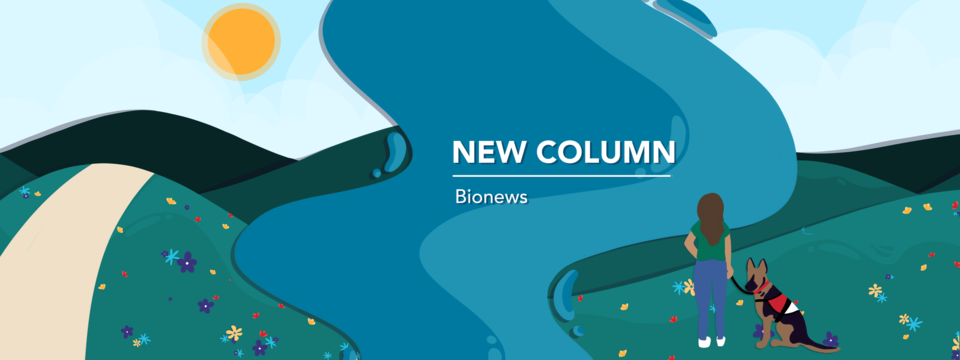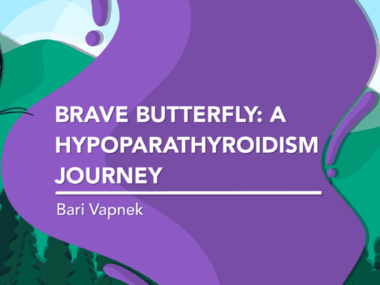The origin story of a brave hypopara butterfly
In her debut, Bari Vapnek talks about her diagnosis and treatments
Written by |

I am Bari Gordon Vapnek, and I’m thrilled to share my brave journey with hypoparathyroidism here in this new column.
Living in Florida, I’m a 51-year-old mother of two: a 25-year-old daughter, Drew, who’s a chiropractor in Atlanta, and a 23-year-old son, Harrison, who’s a sports director for an NBC-TV station in Louisiana. They’re my most significant accomplishments and my reason to continue to fight, advocate, and live each day to its fullest while creating everlasting memories. My family means everything to me.
At age 25, hours after I had a total thyroidectomy for Graves’ disease, where the body makes too much thyroid hormone, I had my first calcium crash. It felt like a stroke.
I was immediately diagnosed with postsurgical hypoparathyroidism, as the four pea-size parathyroid glands, which surrounded my thyroid, were damaged. That meant my body no longer produced calcium. As a result, I was told to take 20 calcium tablets daily; that became my lifeline, along with activated vitamin D, the standard of care for what’s commonly called hypopara.
I struggled to take all those pills. Beyond that, I wasn’t given any information about my diagnosis, except that it was rare.
I had to end my career in new business development, where I was a director. Nine months after the thyroidectomy, I gave birth to Drew, my precious little girl, thanks in part to my surgery and my hypopara. Two years later, Harrison arrived. At that point, I was feeling great as pregnancy was masking the hypopara symptoms. I didn’t feel the negative ramifications of my diagnosis until 2003.
I was tired and lethargic. I figured it was because I had two kids under age 3, but then the nausea started. I continued to take all 20 calcium pills at once each night. I wasn’t advised another way. I lived on Zofran (ondansetron), which blocks the action of serotonin and can prevent vomiting. My thinking wasn’t clear; I always felt foggy. But no matter how sick I felt, I was there for my kids and their daily activities.
In 2005, I had an episode that felt like a seizure. As I was becoming very ill, my husband called 911. I didn’t know what was happening. I felt for my little kids, who had to witness their mom rushed off in an ambulance while they went to a neighbor’s. I ended up spending a few weeks in the hospital, where I was introduced to a new endocrinologist who told me the proper way to take my calcium. I was also diagnosed with early stages of chronic kidney disease (CKD).
The days went slow; the years flew. I still felt awful and misunderstood. I lost friends because I didn’t feel well enough to go out. I missed some days of my kids’ lives, and days that I hope they forgot. One thing they knew was that Mommy tried her best.
My CKD progressed to stage 3A, for mild to moderate disease, and my calcium fluctuated. I was at the lab three days a week. But in 2015, soon after its approval by the U.S. Food and Drug Administration, my doctor suggested I try Natpara (parathyroid hormone, or PTH) through a once-daily injection. It made me feel better and gave me a pep in my step.
On Natpara, in fact, I took Harrison to San Francisco to see a football game, have a nice mommy-son vacation, and make lasting memories. I’m not an athlete, but he and I rode bikes across the Golden Gate Bridge. That was an accomplishment even the 18-year-old healthy version of Bari didn’t think she could do.
In the fall of 2016, however, I had a life-altering calcium crash, which left me four minutes from death. During my weeks in the hospital, I did research, read papers, and saw that one author was a hypopara specialist in Boston. I was able to secure an appointment with him. I went alone and sat for hours learning about hypopara. He weaned me off the Natpara, returned me to the standard of care, and inspired me to write my story, later published as a Medium article, “Hypoparathyroidism — Rare Disease Nearly Kills a Woman,” though it was first available on World Hypopara Day in 2019.
I never recovered from that crash. Even the expert didn’t know what to do. Suddenly, my whole world further changed as my father died and my husband left. I felt alone and hopeless. Wanting to give up, I emailed a Stanford doctor who was running a Phase 1 trial for a long-lasting PTH. He told me, “Don’t give up. There is hope.”
He saved my life. He introduced me to TransCon PTH, and in December 2019, I became patient No. 1 in the Phase 2 clinical trial for the drug. By my second dose, I felt alive. It was a game changer.
This drug, which later became Yorvipath (palopegteriparatide), gave me a chance to work part time in my friend’s store, something I never thought I could do. I didn’t think I could work, even if it was only 15 hours a week.
My column will be about this journey, how I turned adversity and obstacles into opportunities while making my kids proud to see that their mom is, in the words of my column title, a “brave butterfly,” spreading her wings of hope.
Note: Hypoparathyroidism News is strictly a news and information website about the disease. It does not provide medical advice, diagnosis, or treatment. This content is not intended to be a substitute for professional medical advice, diagnosis, or treatment. Always seek the advice of your physician or another qualified health provider with any questions you may have regarding a medical condition. Never disregard professional medical advice or delay in seeking it because of something you have read on this website. The opinions expressed in this column are not those of Hypoparathyroidism News or its parent company, Bionews, and are intended to spark discussion about issues pertaining to hypoparathyroidism.






Marcia Gordon
So very proud of my daughter Bari. Because of her fierce determination and intelligence she fought to find out what was causing her inability to feel normal and succeeded in finding out the cause of her condition. Keep up the great fight Bari!
Pam Eskalyo
I am so proud of my baby sister, Bari. Bari is the strongest person I know. She has persevered through adversity and never lost hope. Bari struggles everyday to live her life to the fullest and be present for her family. Bari is an amazing mother and has raised two accomplished children who grew up knowing their mom always tried her best despite her health challenges.
I’m so proud of Bari for using this platform to raise awareness and help others struggling with this rare disease.
Bari makes a difference and makes this world a better place.
Heather Novak
So glad to be writing with you, Bari! Your journey is very moving. It's wild that we were both diagnosed the same year, and it's incredible that you were patient number one in phase 2 for transcon.
Can't wait to read more of your columns!
Linda Adams
I am scheduled for my first injection of Transcon on Tuesday. I am happy and scared.
Patrick
Fantastic column! I believe that ALL rare disease individuals belong to the best family that you never wanted!! I am looking forward to hearing about your journey.
Bari Vapnek
Thank you